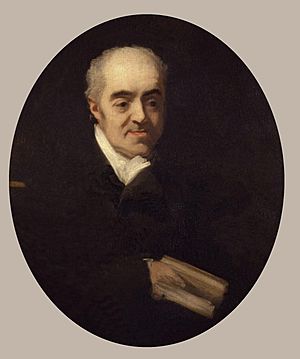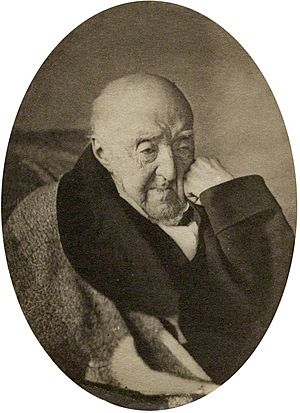Samuel Rogers facts for kids
Quick facts for kids
Samuel Rogers
|
|
|---|---|

Samuel Rogers
|
|
| Born | 30 July 1763 Newington Cross, Islington, England |
| Died | 18 December 1855 (aged 92) Newington Cross, Islington, England |
| Resting place | St Mary's Church |
| Occupation | Writer |
Samuel Rogers (born July 30, 1763 – died December 18, 1855) was an English poet. During his lifetime, he was very famous. However, his friends like Wordsworth, Coleridge, and Byron are more well-known today. Rogers was also a successful banker and collected many beautiful artworks. His notes and memories of his famous friends are important for learning about London's art and literature scene. He used his wealth to support other artists and writers.
Contents
Early Life and Family
Samuel Rogers was born in Newington Green. This was a small village north of Islington at the time. Today, it is part of Inner London. His father, Thomas Rogers, was a banker. He was also a Member of Parliament for a short time.
Samuel's family had strong ties to Nonconformist groups. These were Protestants who did not follow the main Church of England. Samuel himself was a member of the Unitarian church there. He went to school in Hackney and Stoke Newington.
Samuel also took care of his two nephews. They were orphans from a young age. One nephew, Samuel Sharpe, became an Egyptologist and translated the Bible. His younger brother, Daniel Sharpe, became an early geologist.
Becoming a Writer
Samuel Rogers first wanted to become a minister. But his father convinced him to join the family banking business. This business was in Cornhill. Samuel had to take long breaks because of his health. During these breaks, he became very interested in English literature. He especially liked the works of Samuel Johnson, Thomas Gray, and Oliver Goldsmith.
He learned Gray's poems by heart. His family's wealth allowed him to spend time writing his own poetry. He started by writing for the Gentleman's Magazine. In 1786, he published his first book of poems. It included some poems like Goldsmith's and an "Ode to Superstition" in Gray's style.
In 1788, his older brother Thomas died. This meant Samuel had more responsibilities in the banking business. The next year, he visited Scotland. There, he met famous people like Adam Smith and Hester Thrale. In 1791, he went to Paris. He enjoyed seeing the Orleans Collection of art at the Palais Royal. Many of these artworks later became part of his own collection.
Rogers worked very hard to make his poems perfect. Six years after his first book, he published a long poem called The Pleasures of Memory (1792). Some people thought it was the last great example of 18th-century poetry. Byron said, "There is not a vulgar line in the poem."
Life and Friends in London
In 1793, Samuel's father passed away. Samuel then became the main owner of the banking house. He also gained a lot of money. He moved from Newington Green to chambers in the Temple. His close friends at this time included Richard Sharp and artists like John Flaxman and John Opie. He also met Charles James Fox.
In 1803, Rogers moved to a new house at 22 St James's Place. He rebuilt this house and filled it with many artworks. For fifty years, he welcomed all the famous people of London there. When he died, his art collection was worth a lot of money.
Rogers was known for hosting social breakfasts and dinners. Guests included important figures like Thomas Macaulay and Henry Hallam. Getting an invitation to his breakfasts was a sign that you were part of London's literary world. His dinners were even more special.
People liked his conversations and his good taste in art. He was also known for his sharp wit. He often said he had such a small voice that no one listened if he said nice things. Despite his sharp tongue, he had a very kind heart. He helped many writers and artists. For example, he helped the poet Robert Bloomfield. He also helped Thomas Moore and Sheridan. He even helped Wordsworth get a good job.
Rogers was like a literary leader in England. He became friends with Wordsworth, Walter Scott, and Byron. He lived long enough to give his opinion on who should be the next Poet Laureate after Wordsworth. His friends often wrote down his stories and conversations. These were later published in books like Recollections of the Table-Talk of Samuel Rogers. Rogers himself kept notes of his conversations with famous people.
Rogers also held important positions. He was a trustee of the National Gallery. He also served on committees for the British Museum and the rebuilding of the Houses of Parliament. In 1796, he became a Fellow of the Royal Society.
Later Years and Legacy
Samuel Rogers continued to write, but slowly. He published An Epistle to a Friend in 1798. This poem described his idea of a happy life. Then came The Voyage of Columbus (1810) and Jacqueline (1814). His poem Human Life (1819) took him twelve years to write.
In 1814, Rogers traveled through Switzerland to Italy with his sister. He kept a detailed diary of his trip. He had to rush home when Napoleon escaped from Elba. Seven years later, he returned to Italy. He visited Byron and Shelley in Pisa.
His travels inspired his last and longest work, Italy. The first part came out in 1822. The second part, with his name on it, was published in 1828. At first, it was not very popular. But Rogers was determined to make it a success. He made the poem better and hired famous artists like J.M.W. Turner to create illustrations. These were put into a beautiful edition in 1830. This version was a great success. He then made a similarly beautiful edition of his other Poems in 1834.
In 1850, after Wordsworth died, Rogers was asked to become the new poet laureate. But he said no because of his old age. For the last five years of his life, he could not walk easily after a fall. He died in London at the age of 92, which was very old for that time. He is buried in the family tomb at St Mary's Church in Hornsey, Haringey.
See also
 In Spanish: Samuel Rogers para niños
In Spanish: Samuel Rogers para niños


